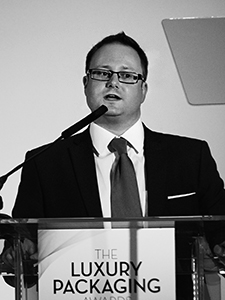“Developing and designing more ecological materials that will decrease environmental impacts at the end of the production chain is on the horizon. For example, in the UK the industry has responded very well to these challenges by developing recyclable and biodegradable packages. Because packaging is a relatively small but visible part of the whole supply chain, there are a lot of diverse interests coming from the part of consumers but also legislators to decrease the use of packaging materials,” notes Chadwick.

Philip Chadwick
One of the innovations driving progress in the food industry is smart packaging, which helps to keep food fresh for a longer time, thereby decreasing waste going to landfills and improving the ecological performance of products.
Packaging pulls a vanishing act
Noora Nylander teaches packaging design and branding at the Lahti Institute of Design in Finland.
“Fibre-based packaging solutions like paper and board will certainly gain popularity as substitutes for plastics in the future. A lot of R&D is also being done to create new packaging materials like biocomposites, biodegradable plastics and combinations of different fibres.”
New bio-based materials should be as user-friendly as – or preferably even better than – current materials. Tomorrow Machine is a Swedish-based design studio that leads the way in developing biodegradable bio-based packages. The company’s vision is to create packaging with a lifecycle of exactly the same length as its contents. Once the package is opened, it dissolves.
Personalised production
IT and digital printing technology have increased opportunities for personalising packaging products, which can now be printed in smaller editions. This trend helps to decrease mass production and boost small-scale fabrication. Chadwick predicts that digital printing will not replace analogue printing but instead both technologies will complement each other.
“Analogue technology will be used in printed packages that are fabricated in bulk. However, digital printing is linked to the sustainability trend as it allows shorter runs with fewer consumed raw materials. That is a big plus for brands.”
Digital printing has brought the packaging industry into the heart of marketing campaigns as well. Major print manufacturers are boldly investing in this field.
“By using digital and 3D printing or laser cutting technology it is possible to produce small quantities cost efficiently. Instead of investing in huge production facilities these new technologies can provide a more flexible alternative. For example, there are several materials that can be used in 3D printing now,” adds Nylander.
Mining social media
People are becoming more willing to provide information about their consumer habits via social media, which provides a valuable source of behind-the-scenes data. Younger generations no longer trust brand messaging but they willingly share consumer information and their user experiences in the social media.
“When we design products we search for information about certain target groups by browsing Instagram photos where people share pictures of their homes or how they use products. From the designers’ perspective this kind of visual observation offers in-depth understanding of the target group,” says Nylander.
While most information is migrating to the internet, Nylander believes that packaging will survive as a print media, with intelligent packages and tags delivering digital information between consumers and producers.
“Brand owners and the packaging industry should try to leverage information from social media more efficiently. Now, most companies are simply content to deliver information through their web pages or social media channels.”
Photos: Tomorrow Machine, UPM
How can the top 10 consumer trends help us to predict changes?
Vesa Puoskari
